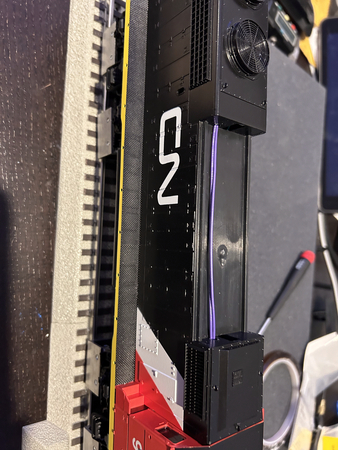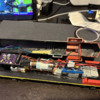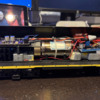Ok... finished.
I 3D printed a shelf for the decoder to sit above the drive tower, and a box for the speaker to sit in. This is a "temporarily permanent" install. I dont really like using 2 sided tape to do stuff, but I did here. This was a "science project". This loco was a $90 York score, and it needs to be repainted into something a bit less Canadian (not to mention the road number is inaccurate).
I just have it running on rollers at the moment as the part of my layout that has a center rail is inoperable at the moment, but I'll find a place to go play with it soon. It connected and ran fine on both my phone and my ipad. Doesnt seem to have issues swapping back and forth between devices, but only one connection at a time it seems.
This was my first time installing a Tsunami 44XX board. I have a few Red Caboose GP9s running on 2200 boards, but the rest of my DCC stuff is Loksound 5Ls. Jury still out on the screw terminals. I do like that you can solder on the loksound boards in any direction, whereas the screw terminals force you to sometimes wrap wires around the back side and in, but it does make it easier for "anyone" to install it. With the voltage converter work needed, its not a solderless install. I also put sunny white LEDs in the lights, which needed 1K ohm resistors for the decoder to not blow them up.
A 6A bridge is under the blue board, which is the voltage converter. Its screwed to the diecast weight for a heat sink. The voltage converter is set to put out 16V DC (I bumped it up a volt from the pic above).
The Blunami board mount is just a flat plate with some posts. The rear post is screwed in through the frame. The front 2 posts just sit in some holes that were already in the weight. There's a rounded hood for the flywheel to keep the wiring away from it.
Stuffing the speaker in the air filter box in the roof meant I had to add a few holes to the shell and run the speaker wires through the dynamic brake pocket in the shell. Cant see it, no big deal here.
The interface resizes itself for an iPad.
Just playing around.... It will take some time playing with the CVs to get it all to run well. First thing I did though was set the Accel to 120 and the Decel to 80. Thats what I use in all my other locos. Equate it to TMCC momentum settings.
In total: $205 board, $.60 bridge, $6 voltage converter and a $10 speaker. I dont calculate the price of 3D printer filament because the 2m it took is pennies. So $222 in the locomotive. About the same as a PS3 upgrade, and way cheaper than a ERR set. Tons of sounds, nearly infinite adjustment, people may start realizing what they were missing out on with these proprietary systems.
One thing though: Don't stock pile these decoders for installs. Buy them as you need them. These are V1.0, it would not surprise me if they end up adding tweaks , adding/changing sound files or advancing with bluetooth parts, etc... to V1.1 and so on, and the firmware boards isnt "upgradable" like a Loksound board is. Just install the version you can buy at the time and buy another board for the next install. They'll still play with each other because its all DCC, but you'll kick yourself if they upgrade the sound fidelity and you've got a stack of old ones.











